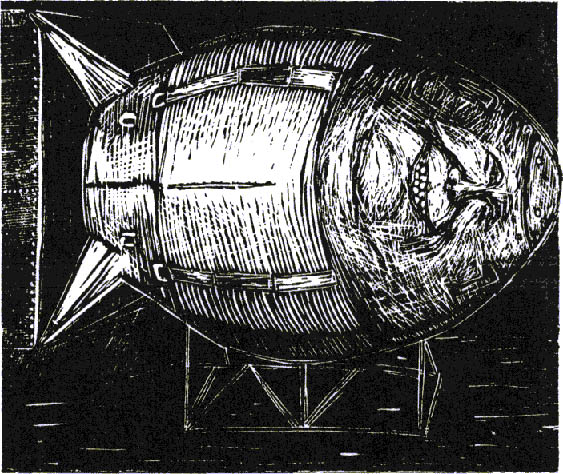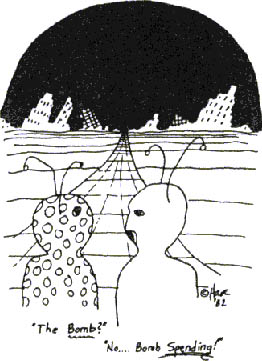|
The Psychology of the Arms Race By Barry Zwicker
THE HEART OF THE ARMS RACE, psychologically, is the perception of a menacing hostile "out-group," namely the USSR. A wealth of independent evidence (see "The Myth of Symmetry" elsewhere in this issue) shows that the strength of this perception is not justified. Here, however, the purpose is not to discuss military equipment, GNP's or geopolitical maps. It is to try to deal with the Cold War in psychological terms only. The perceived existence of a hostile out-group automatically creates an in-group, namely "ourselves," "the West" or "the free world." This double creation — the "us" and "them" — requires in turn a relationship between the two. Walter Lippmann in his 1921 classic Public Opinion explored the distortions inherent in such a relationship, a relationship which ". . . mark(s) out certain objects as familiar or strange, emphasizing the differences, so that the slightly familiar is seen as the very familiar, and the somewhat strange as sharply alien." These distortions have generally been encouraged by tribal and nation-state leaders. A populace convinced along these lines is less questioning when it is called upon to make war upon the out-group. In this sense, simplistic stereotyping of "good guys" and "bad guys" served to help the tribe survive and conquer. But such a psychology integrated into the politics of today's nuclear nation-state becomes a death mechanism. This is because the psychology requires weapons buildup and leads to confrontation. Today's weapons are capable of destroying everything. Total destruction is a condition neither of conquering nor surviving. Marshall D. Shulman investigated the psychology of the Cold War in a talk titled "Tell Me, Daddy, Who's the Baddy?" Shulman, Director of the Averell Harriman Institute for Advanced Study of the Soviet Union and Adlai Stevenson Professor of International Relations, gave the talk May 6 at a Symposium on Political and Psychological Aspects of Soviet-American Relations at Columbia University, New York City. "The title . . . is not frivolous," Shulman said. "It suggests an authority figure identifying the hostile out-group, thereby giving us . . . comfort, identity, stability, orientation and a relief from complexity." Shulman assured his audience that he believed there are "real and serious differences" between the USA and the USSR. "But familiar psychological mechanisms," he continued, "most often operating below the conscious level, tend to make these differences more absolute and therefore more intractable . . ." What are the "pictures in our minds" of the Soviet Union, and where do they come from, Shulman asked. "They come from many different sources, some from preconceptions whose source may be long forgotten, some from our particular experiences. "For example, an emigreé from the Soviet Union, who may have spent years in a labor camp or years waiting for an exit visa, when he thinks of the Soviet Union, may think primarily of the police and party bureaucrats with whom he had to deal, and the vision that comes to his mind is of a bunch of thugs with whom one cannot and should not do business . . . A businessman, who has dealt mostly with economic managers, may visualize the Soviet Union as a country of hard-bargaining but hard-working managers . . . To the professional military planner, the Soviets are the "reds", the enemy, ruthless, omnicompetent poised to attack."
Of course, very few people have visited the Soviet Union in any capacity. The prevailing perception, therefore, is fundamentally a mass media creation. Shulman went on to list the several anxieties and tensions of everyday life in North America, ranging from economic insecurity to vulnerability to nuclear destruction. "Confronted with anxieties with which (he or she) cannot cope, the individual falls back on some familiar defence mechanisms," Shulman suggested. They include displacement, denial and projection. In displacement, fears, failures and anxieties from other sources are "commonly attributed to the Soviet Union as the source of our troubles. We have seen this in the attribution to the Soviet Union of responsibility for all upheavals in the Third World (as well as) the anti-nuclear war movement . . ." The most striking instance of denial, Shulman said, is the false belief that nuclear war cannot happen. It is projection, however, which is probably the most widespread and threatening to our survival. It's as tricky as it is dangerous. In its simplest definition, it is when we blame others for those very faults we don't want to admit in ourselves. Its everyday occurrences are myriad. It's the kind of mechanism which seems to maintain a reserve of applications in each of us, no matter how many applications we discover and root out. For instance, we feel justified in hating the "Soviet Union" (note we normally avoid the phrase "people of the Soviet Union") because of our perception that the "Soviet Union" is "bent on world domination." Another manifestation of projection, Shulman pointed out, is its double standard under which we "look with indulgence on what 'we' do or say, and with harsh severity on what 'they' do or say." This thinking in its extreme form leads to "a Manichean struggle between God and Demon, between absolute good and evil." This aberrational double standard is suffered and promoted by U.S. President Reagan when he describes the Soviet Union as "an evil empire" while he fails to see or mention the number of corrupt and despotic regimes the United States has aided, protected or in some cases (such as the Shah's Iran or in Pinochet's Chile) even established. But to blame Reagan for everything is itself an exercise in projection. Each of us is responsible for projection insofar as we practice it. And although we do not do so equally, we all do practice it. That is why Sylberberg's 7-1/2 hour tour de force film Our Hitler was so aptly titled. By exploring some roots of projection, Shulman showed how deeply ingrained it is. Yet that very realization gives added hope that we can at least root it out from that misshapen corner of our minds reserved for the Cold War and all its hostile appurtenances. This is especially important for journalists to do. For as gate-keepers, we control a flow of "facts" about the Soviet Union (and the "free world") to the public. Yet an important lever in our control mechanism is a projected prejudgment about "us" and "them." Thus are we instruments for our own deception. Projection can be seen in infants as young as eight months, and in animals. To put Shulman's observations into layman's terms, infants develop a sense of identity through building on bonds of affection and the familiar. At the same time infants reject those people and events which are unfamiliar and which seem to act aggressively. These "exaggerated beliefs associated with a category" enable the simple mind of the infant or animal "to handle countless small stimuli." The exaggerated beliefs also offer stability and certainty. The price is that the infant gives up what psychologists call "validity". In ordinary language this might be expressed as "the truth." Psychiatrist Charles Pinderhughes goes so far as to suggest that any constant relationship which is without ambiguity is "basically paranoid." Shulman gives as examples the common acceptance that Soviet military programs necessarily "reflect hostile intentions; American military programs are by definition defensive. The expansion of Russia and the Soviet Union to the Pacific is proof of inherent Soviet tendencies to expand until it conquers the world; the continental expansion of the United States is a matter of right. Soviet activities in the Third World are manifestations of aggression; United States activities in the Third World are altruistic. Soviet espionage is traitorous; American espionage is patriotic." The terrible danger in all this is that the "enemy" is de-humanized. Thus "our side" is relieved of inhibitions against immoral behavior; any action is justified. This de-humanization process in the minds of the Nazis (and in the minds of large numbers of Germans, it must be said) against the Jews, communists, Slavs and others led to atrocities including the gas chambers. The Roman Catholic bishop in Washington state who referred to a Trident nuclear submarine — each one can unleash 2,040 Hiroshimas — as the "U.S.S. Auschwitz" is helping us see what, psychologically, we have become, insofar as we countenance the unleashing. Shulman concluded: "The human mind needs its stereotypes . . . But what we can do is to seek continuously to refine our stereotypes . . . so that they come closer to a reflection of reality. This will in turn make possible a mobilization of the intellect . . . It may be that only under great duress do human beings bring their intellects into play to give a sense of proportion to the urges and beliefs that arise from instinct and emotion. The present head-long course of events surely constitutes that great duress." A layman might add that the media have greater responsibility than any other institution to refine stereotypes, to explode myths. The media have the capacity to do it. Long gone, for instance, are the racist stereotypes once common in the press. Previously taboo subjects such as venereal disease and incest have been brought out into the open. In the last few years stereotypes about the aged and the handicapped have been exploded vigorously and repeatedly enough that they have lost much of their stultifying power. We are freer and can think more clearly because of these stories and the attitudinal changes within the media that have followed. This is the finest gift journalism can bring: understanding, refinement. On too many subjects journalism's contribution is endless rehashes of stereotypes in the guise of news. We now face the last-bastion stereotypes, those most fervently and universally held, the mutually-supporting ones about life-and-death issues. At the heart is the stereotype about the all-time baddy, the "red menace." If we cannot find the courage to take a fresh look, and a historical look, at this pervasive "given" we increase the risk of a "war" against people most of us have never met. — B.Z.
Published in Sources Summer 83
Sources |


